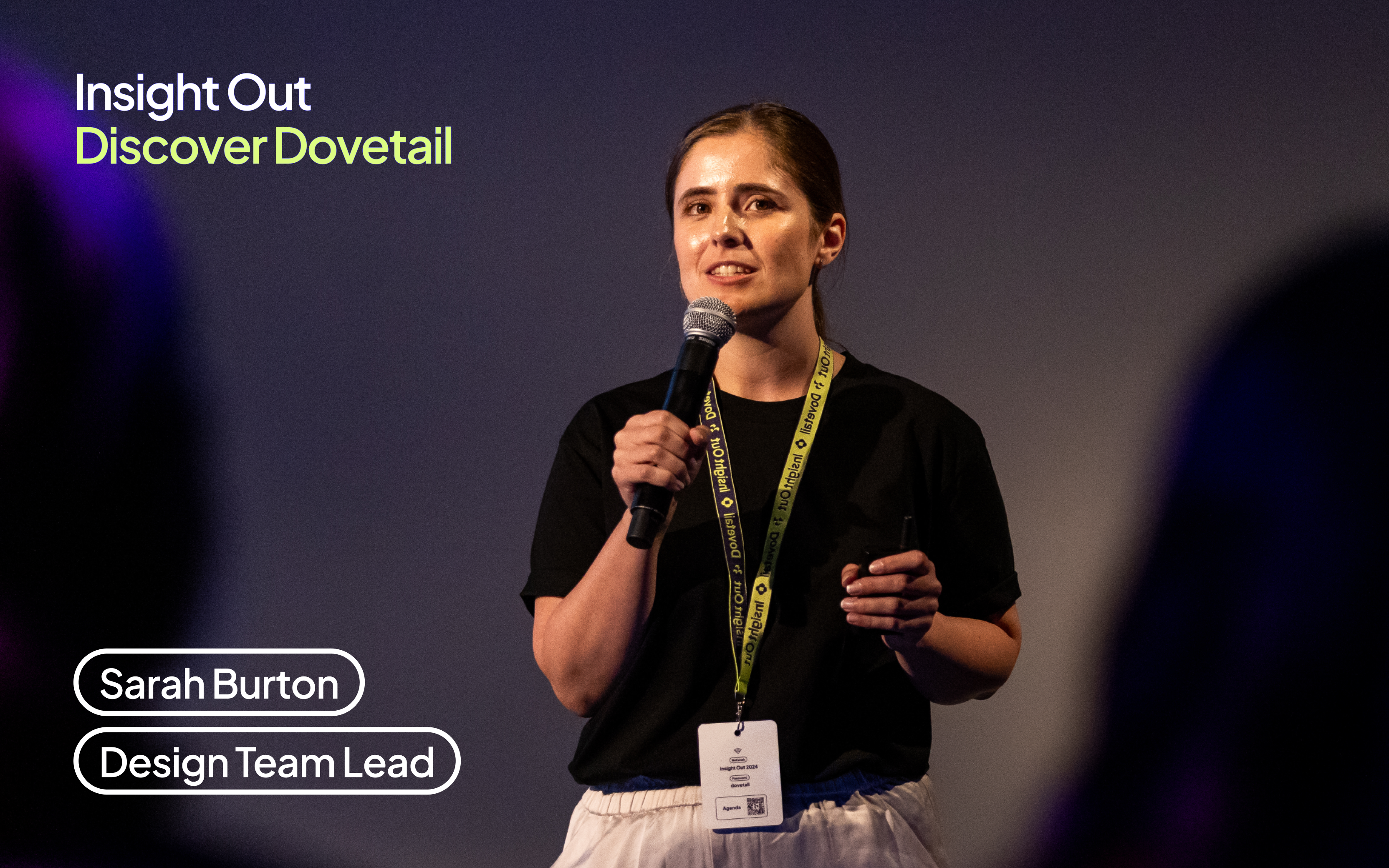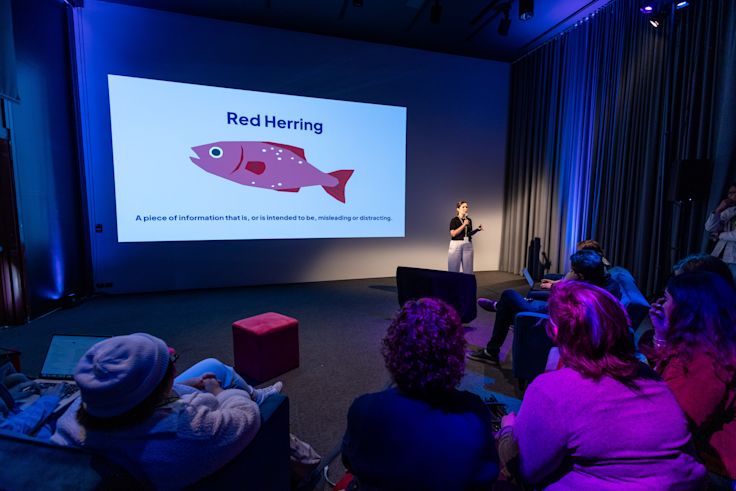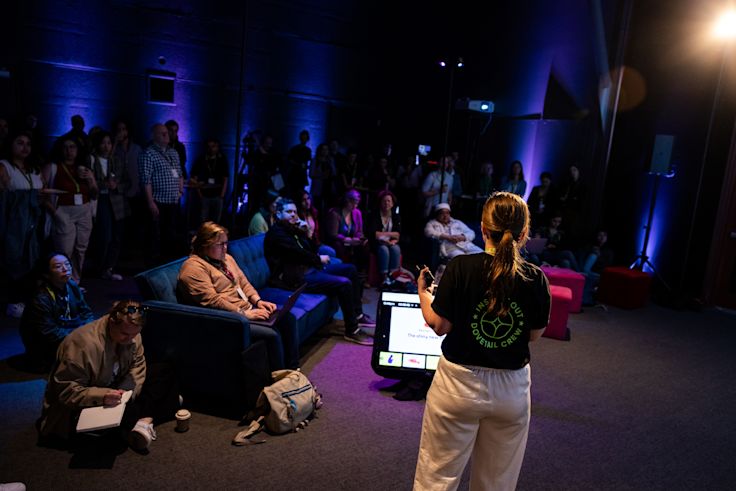Prioritizing product like Sherlock Holmes with Dovetail's Sarah Burton
Tags
[insight out]
Published
28 June 2024
Content
Sarah Burton
Creative
Charlie Yuncken
Share

In this talk, Dovetail Lead Product Designer Sarah Burton explores how to prioritize product development with the keen eye and analytical skills of Sherlock Holmes. Discover how to apply these investigative techniques to make smarter decisions and drive impactful outcomes.
Sherlock Holmes, a fictional character created by British author Sir Arthur Conan Doyle, is the archetypical detective, known for his powers in logical reasoning and deduction. He is, at his core, a problem solver.
He’s given mysteries, goes out, finds clues, takes them back, solves the problem at hand, and saves the day in this process. Some of the clues he finds seem more important than they are. We call these red herrings.
Red herrings
A red herring is a piece of information that is or is intended to be misleading or distracting.
It differs from irrelevant information in that it feels much more important than it is. And it plays an important role in detective stories. As consumers, it diverts our attention away from the important information, so we can have a more surprising and engaging story.
But, unlike us, Sherlock Holmes can’t afford to be distracted by them because then he can’t solve the mystery. Luckily, he’s an expert at spotting the information that is not important and keeping his eye on the ball, solving the problem at hand and saving the day.
I’m Sarah, a lead product designer here at Dovetail. One of the many ways that I, a woman in the 21st century working in tech, and Sherlock Holmes are alike is that my job in product development is also about problem-solving.
We come across many problems all the time. It is immediately obvious that some of these are very important and are going to have a high impact on our business. We know what to do with them—they need to be prioritized and solved right away.
For other problems, it’s immediately obvious that they’re not important. They have a low impact on our customers and our business. These problems are not a threat to us.
However, there are a subset of problems that simultaneously are real and might be something we need to solve eventually but are also a distraction from where our attention should be. These are product-development red herrings, and they are dangerous.
Focusing our time and attention on a product-development red herring means, at best, it prevents us from pursuing maybe more profitable paths. At worst, it could be actively harmful to our customers and our business.
How can we catch these red herrings?

How to spot product-development red herrings?
I’m going to run you through five red herrings I’ve encountered working in product development and some methods for you to spot them a mile away. Then, like Sherlock Holmes, you’ll be able to keep your eye on the ball, solve the problem at hand, and save the day.
Red herring #1: The shiny new thing
You’ve found a problem. Now, you might be familiar with the following quote from Henry Ford: “If I’d asked people what they wanted, they would have said faster horses.”
Or what about this one from Steve Jobs? “A lot of times, people don’t know what they want until you show it to them.”
This is good advice, but it can be harmful if you stop at that top level. These quotes can be weaponized to justify building whatever you want with the underlying assumptions that customers don’t know what’s good for them.
The shiny new thing is when we focus on the new and exciting technology or idea in sight and leave old ideas in the dust. We make excuses to ourselves about following the shiny new thing by saying we’re innovating.
But there is a real difference between true innovation and falling for this red herring. Unsurprisingly, given where we are today, that difference is a deep understanding of your customers and their problems. While they might not have the imagination to picture all the creative ways you can solve their problems—that’s our job—they understand those problems better than anyone else.
How to catch it: Deeply understand your customer’s problems
I can hear you thinking, “But, Sarah, AKA our modern-day Sherlock Holmes, that seems all well and good. But how do we actually do that?”
I’m sure a lot of you are familiar with that feeling when you’ve gone out, spoken to customers, kicked off your project, done your research, come back, and while you’re doing your analysis, you get that sinking feeling of realizing you haven’t gone deep enough.
By this time, maybe you’ve run out of time or budget. Either way, you didn’t ask the right questions, or maybe you didn’t know what you didn’t know before you started.
I accomplish this with Dovetail by using some of the new features. Magic Highlights and Magic Summary enable me to carry out analysis as I go. Instead of having to wait until the end of the project to do that analysis and find gaps, I can skip over vast parts of this manual labor to start getting insights faster on the go.
This helps me make adjustments on the fly, and I can change the questions I’m asking and make sure I’m getting deeper. By the end of the project, I can be confident I have found the right problems and I’m going to catch this red herring.
Red herring #2: The circular problem
Maybe you’ve found a true customer problem. What could possibly be the catch in this case? We might be encountering red herring number two, the circular problem.
A circular problem is when you get stuck solving problems you have created, and you’re in a circular loop. If the problem only exists in your ecosystem, and your customers aren’t talking about this problem, you are the problem.
In this situation, we shouldn’t be working on solutions that help users resolve these problems. We should be figuring out the root cause and solving those problems for them.
Getting stuck on this red herring can be dangerous. While you’re cleaning up messes you might have created, your competitors can be innovating past you, solving real customer problems.
We aren’t immune to this at Dovetail. We might have introduced a circular problem with our tag taxonomies. I’m sure some of you are familiar with the amount of effort it takes to manage those.
We’ve done some work, and we could continue to do some work, to help our customers manage those complex tag taxonomies. But we could also take a moment of reflection. Are we putting Band-Aids on a wound we’ve created, and do we need to solve that in a different way?

How to catch it: Be on the lookout for product-specific language
Language is a real key here. When you are describing the problem you found or the insight you have, does the language you’re using tie directly to your ecosystem?
A primary customer problem will be framed outside the context of your product or service.
A secondary problem might use language that only exists in that ecosystem. You might be dealing with one of these red herrings in that case.
I use Dovetail to keep a high level of themes and insights across the whole project. Different views like Canvas or even Board enable me to maintain that high-level view so I can look for patterns.
Using Magic features like Cluster helps me to be more objective with the groups I’m putting together. I can remove my underlying assumptions and, if that product-specific language is appearing, I can catch it here and ensure I am solving real customer problems and not getting stuck in a circular loop.
Red herring #3: The squeaky wheel
You found a primary true customer problem. Now is the time to think about whether we are dealing with a flash in the pan or an enduring, persistent customer problem. Will solving this problem have a long-term impact on your customers’ needs?
This is when problems appear loudly out of nowhere and get the grease over more enduring customer problems that we’ve known about.
The problem with the squeaky wheel is that it feels really urgent, really loud, but it’s often less important than problems we’ve known about for a long time. This is because true paradigm shifts—where things come out of nowhere—are pretty rare.
When ChatGPT launched, it was a paradigm shift that changed the game. We needed to respond to that in many different areas. But, typically, these problems that appear out of nowhere are less important than the more enduring, persistent ones.
How to catch it: Be wary of problems without roots
Persistent problems have roots and should be an extension of existing knowledge that you can trace back to known truths. They should map to what you already know about your customers.
If this latest issue does, you can feel pretty confident you’ve got a persistent problem. If it doesn’t, take a moment to assess whether you’re dealing with a paradigm shift or whether this is a squeaky wheel that is a distraction.
I use Dovetail as a repository for all our known customer inputs from me and my colleagues. If I’m dealing with a problem that appears loudly out of nowhere, I search for it here in the hub and look for those roots.
If I find them, I can feel confident it is a persistent problem. If I can’t, I might be dealing with a squeaky wheel.
The beauty of this is that it only gets stronger over time. The more information that’s put in there, the easier it is to find those roots and make sure you’re dealing with those persistent problems.
Red herring #4: The molehill mountain
So, you have found a primary persistent true customer problem. This one can hurt a little for product-focused people like me, but will it actually hurt our business not to solve this problem? Are we making something out to be much bigger than it is?
This is a moment when we have to be quite ruthless, and it can hurt as a product person. Solving this problem or not solving this problem might be negative, but not solving this problem might be neutral. It might not have a size impact.
How to catch it: Know what will happen if you do nothing
Typically, we think about the impact if we solve this problem. What’s the impact on our customers? What’s the impact on our business? Here is where I flip the script. What will be the impact if we don’t?
The best way to do this is to collaborate. What I value here at Dovetail is highly collaborative, cross-functional teams. We truly believe the best problems and solutions come when we join together. It’s impossible to maintain all the context yourself. So, bring your team in and play out these scenarios. What happens if we don’t fix it?
I support this in Dovetail with our collaboration features, like fields, tags, or comments. I can keep discussions contextual in the platform, so we can maintain this source of truth and keep the discussion of how important this is next to the context.
This means I not only catch this red herring once, but if anyone else finds this information, they catch it as well. This means we’ve not only caught the red herring ourselves, but we’ve caught it forever.

Red herring #5: The wrong person
So, you have found a primary, persistent, punitive, true customer problem. What now? It sounds like you have a pretty good problem on your hands, but a red herring can operate at a personal level too.
This is the moment to ask yourself: Are you the best person to work on this problem? Or are you the wrong person?
Ownership is good. It’s an important trait we value at Dovetail. Given you’ve found this problem, which seems to be pretty important at this point, you should probably make sure it’s resolved. However, you might not be the best person to solve it. It’s a time to be reflective.
Maybe you don’t have the skills. Maybe you don’t have the context. Maybe you simply have too much on your plate.
How to catch it: Know your strengths and weaknesses
As my main man, Socrates would say: Know thyself. Be ruthless here, and ask yourself: With everything you’re working on in your business, why should you be the one to solve this?
In the past, sometimes I would solve problems I was less suited for because it would take too much time to get someone else up to speed.
This is where automation has somewhat changed the game. Features in Dovetail like magic summarization can be used to give context to your coworkers so you can afford to get the right person every time.
You could do this at a micro level, like an individual interview, or a macro level for all the information across your hub. Either way, you can give that download in a beautifully packaged way, faster than ever.
Final thoughts
You are dealing with a primary persistent punitive true customer problem, and you’re the best person to work on it. What now?
Now, you actually need to solve the problem. But, having considered the five red herrings we’ve run through today—the shiny new thing, the circular problem, the squeaky wheel, the molehill mountain, and the wrong person—you can be confident that, like Sherlock Holmes, you’re going into the room knowing you have the most important information to solve it.
Editor’s note: This article is a condensed overview of Sarah Burton's talk in the Discover Dovetail room at Insight Out 2024.
Related Articles


